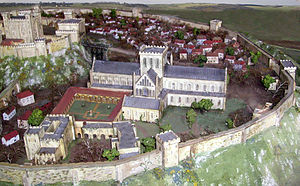- Old Sarum Cathedral
-
 A model of Old Sarum in Salisbury Cathedral
A model of Old Sarum in Salisbury Cathedral
Old Sarum Cathedral was a Norman cathedral built at Old Sarum, near modern day Salisbury, Wiltshire.
After the Norman conquest of England in 1066, William the Conqueror used Old Sarum as a base of operations. William moved the bishopric from the Anglo-Saxon Sherborne Cathedral to Old Sarum, appointing his nephew, Osmund de Sees, as his chancellor and Bishop of Salisbury.[1] Osmund had the first cathedral at Old Sarum built, completed in 1092. Sarum is described as a fortress rather than a city, placed on a high hill, surrounded by a massive wall. Peter of Blois (c.1135–1203) describes the site as "barren, dry, and solitary, exposed to the rage of the wind; and the church [stands] as a captive on the hill where it was built, like the ark of God shut up in the profane house of Baal."[2]
The Norman cathedral suffered extensive damage in a storm, traditionally given as taking place only five days after its consecration.[3][4] Osmund's successor, Roger of Salisbury, rebuilt and enlarged sections of the cathedral. Roger also oversaw the construction of a stone royal palace on the hill site between 1130–1139.
At its greatest, the Norman cathedral was 185 feet (56 metres) from end to end, smaller than most of the cathedrals being constructed at the time. Built in the standard cruciform shape, the building had a nave of seven bays with cross-shaped piers, an apse and a central crossing tower, as well as several peripheral chapels.[5]
The site at Old Sarum was exposed and had a limited water supply.[6] After a dispute between the clergy and military officials at the nearby castle, Bishop Richard Poore decided to move location. A plan to move the cathedral to Salisbury had already been put forward to Richard I in 1194. An official mandate for its destruction was given by the king and the move began in 1219.[7] Stone from the old cathedral was used in building the new, and in 1220 the new site was consecrated.[8] By 1258 the new cathedral had been completed in an Early English style.[9]
A licence to build the new cathedral close wall using stone from Old Sarum Cathedral was granted in 1327 and the wall was built in 1331.[10]
References
Bibliography
- Britton, John, The history and antiquities of the cathedral church of Salisbury, London: Longman, Hurst, Rees, Orme, and Brown, 1814
- Ecclesiological Society, Old Sarum Cathedral in The Ecclesiologist, Vol. 3, Cambridge: Cambridge Camden Society, 1846
- Evans, Sydney. Salisbury Cathedral: A Reflective Guide, Salisbury: Michael Russell Publishing, 1985
- Fernie, Eric, The Architecture of Norman England, Oxford: Oxford University Press, 2002 ISBN 9780199250813
- Reyerson, Kathryn L.; Powe, Faye, The Medieval Castle: Romance and Reality, Volume 1 of Medieval Studies at Minnesota, Minneapolis: University of Minnesota Press, 1991. ISBN 9780816620036
- Scalberg, Daniel A., The Kregel Pictorial Guide to Christian Heritage of England, Grand Rapids: Kregel Publications, 2001. ISBN 9780825436635
- [Unknown], Old Sarum, London: English Heritage Guidebooks, 2003
External links
Categories:- Visitor attractions in Wiltshire
- Grade I listed buildings in Wiltshire
- Churches in Salisbury
- Former cathedrals in England
- Destroyed landmarks
Wikimedia Foundation. 2010.

